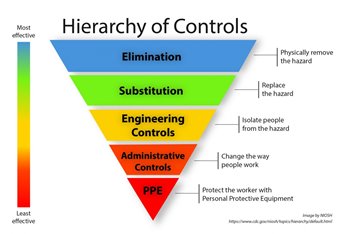The Great American Eclipse and the Hierarchy of Controls
On Monday, April 8, people in a small slice of North America will have the chance to view a total solar eclipse. Viewing this type of eclipse is a rare opportunity, and a potentially hazardous one.
Earth experiences a total solar eclipse, during which the moon completely blocks or obscures the sun, about once every 18 months. Seeing one is rare, though; each total eclipse is viewable from a tiny fraction of Earth’s surface. Some of them cross Antarctica or the middle of an ocean.
Americans are making plans, and some are even traveling hundreds of miles, to get a better view of the eclipse on Monday. Most (hopefully) will be using specialized glasses for protection.

Looking directly at the sun, even during an eclipse, can cause eye damage. Doing so with binoculars or a telescope without a special solar filter “will instantly cause severe eye injury” (NASA).
Clearly, we’ve identified a hazard: The brightness and intensity of the sun's rays poses a threat to the health and safety of eclipse viewers. Like any hazard, we can use the Hierarchy of Controls to evaluate potential methods, or combinations of methods, to eliminate or control the hazard posed during the eclipse.

The hierarchy suggests five methods for controlling hazards in the workplace. From most effective to least effective, these are:
- Elimination
- Substitution
- Engineering Controls
- Administrative Controls
- Personal Protective Equipment (PPE)
By following the hierarchy to select protection methods, we can be confident that our loved ones are enjoying Monday’s Great American Eclipse in the safest way possible.
Enter your zip code on NASA’s Eclipse Explorer to see what time will provide the best view of the upcoming spectacle.
Control Method 1: Elimination
Elimination makes sure the hazard no longer exists by physically removing the hazard or moving the work to a less hazardous area.
The hazard in our scenario is the sun. The brightness of the sun, to be more specific. The sun does not have a “dimmer” switch, or at least we haven’t found it, so reducing the brightness is not an option. Eliminating the sun completely, meanwhile, creates more problems than it solves.
With our main star gone, Earth would enjoy about eight final minutes of daylight before going dark and losing our gravitational force (according to Einstein).
Control Method 2: Substitution
Substitution means changing out a material or process to reduce the hazard. If we are welding something that could feasibly be soldered, we can substitute that extremely hot and bright weld with the less hot and bright process of soldering.
Or, maybe we can substitute a hazardous material in your process for a less hazardous one. While there are other sun-like stars in our solar system, the benefits of replacing our sun with one of them are unclear—and so are the logistics.

Control Method 3: Engineering Controls
Engineering controls reduce exposure by preventing hazards from coming into contact with workers without prohibiting them from doing their jobs.
We can imagine a greenhouse-like structure built of ISO-compliant solar viewing materials that could allow a group to view the eclipse safely. To use the Hierarchy of Control effectively, however, safety professionals must consider the feasibility of each method or solution.
In this case, engineering a solution for a once-in-a-lifetime hazard that lasts for 4 to 5 minutes may not be feasible.
Control Method 4: Administrative Controls
Administrative controls change the way work is done or give workers more information.
For eclipse viewing safety, we might implement a system to distribute viewing glasses, or even perform quality control inspections of the gear. We can also post clearly worded, hard-to-miss warning signs in eclipse viewing areas—“Staring at the sun will damage your eyes.”
Now we’re getting somewhere.

Control Method 5: Personal Protective Equipment
When higher level control methods are not possible or feasible, PPE is the last resort for safety.
On April 8, 2024, take steps to enjoy the Great American Solar Eclipse safely. Educate yourself and any fellow solar eclipse spectators on the hazards posed by the sun’s intense rays Get proper PPE. Inspect the equipment for flaws or any signs that its protection may be inadequate. Then, gear up and look up!
And remember: Your retinas do not have pain receptors. Do not attempt to view a solar eclipse without proper eye protection and be cautious of homemade or improvised viewing methods that may not offer adequate protection.
Find a Post
Recent Posts
Compliance Archives
Download Our Latest Whitepaper
Knowing why TSDFs reject loads of hazardous waste—and the exact steps to follow if it happens—can reduce your anxiety and uncertainty about rejection.

By submitting your phone number, you agree to receive recurring marketing and training text messages. Consent to receive text messages is not required for any purchases. Text STOP at any time to cancel. Message and data rates may apply. View our Terms & Conditions and Privacy Policy.
